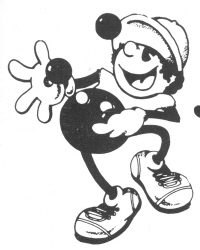 |
Joggler's Jottings by Bill Giduz, editor Davidson, North Carolina
|
Page 23 Fall 1984
 |
Joggler's Jottings by Bill Giduz, editor Davidson, North Carolina
|
|
The
case for juggling as sport
The
ultimate human achievement in juggling will always be its
presentation as an entertainment art. Someone who both masters the
skills and presents them to the public in an entertaining fashion
deserves a round of applause and a decent paycheck.
The
IJA celebrates this height-of-the-art achievement in its U.S.
Nationals, Juniors and Teams Championships, all of which are judged
through a combination of scores for technical prowess and
presentation skills. But why is it that technical juggling without
accompanying entertainment is not generally recognized as an
athletic endeavor in its own right?
Watching
Olympic coverage on TV prompted that thought. In a short segment on
events surrounding the event, a street entertainer was filmed
juggling chain saws. Appreciative of the coverage, I was nonetheless
miffed that the media invariably presents juggling as colorful
entertainment, rather than as athletics.
Aren't
the skills displayed by Albert Lucas in his discipline in the U.S.
Nationals as legitimately athletic as those of Mary Lou Retton in
gymnastics? Yet Lucas is recognized as an entertainer by the world
at large, while Retton gets acclaim as an athlete.
Herein
lies a golden opportunity for growth and development of the IJA and
the popularity of juggling in general. It's time to define juggling
as a sport.
Almost
all of the trappings are in place. The unabridged version of
Webster's Dictionary carries two definitions for sport. Juggling
qualifies easily under the first:
If
the goal of the IJA is to promote juggling, it is leaving a
large segment of the population out of its mission. Those are the
multitudes of jugglers who enjoy the athletic side of the skill
without caring to present it as a performing art. After a certain
point, association with the IJA provides little positive feedback
for the athletic practice of juggling. Without a system for
measuring advancement, or a competitive forum for judging technical
skill against others, many jugglers lose interest and move on to
other diversions.
The
purely athletic contests in place now - numbers and joggling -
partially address this concern. Athletic skills are also promoted in
convention workshops, but unless a technical juggler is either very
fast on his or her feet with three balls or very consistent with at
least five clubs or seven objects, there is no forum in which to
test those new skills.
A
great deal more can be done. The difficulties of creating something
(athletic competitions) from nothing (the status quo) are enormous.
Mainly they center around creation of a competitive format,
agreement on a common language to describe tricks, dissemination of
the system, and finding the manpower (or judge-power) to run it.
But
in this sports-oriented society, juggling's recognition as a new-age
sport could lead it to levels of public participation we can
barely imagine today. Dream if you will of a Dick Buttons-type
commentator at televised coverage of the 1992 Olympics.. .
As
in gymnastics and skating, juggling competitions could be broken
into compulsory and freestyle exercises. To involve even more
people, and provide a structure for advancement and reward from an
early stage, several levels of competition should be established.
With everyone performing the same compulsory moves, judging can be
fair and should not be difficult. An anything-goes freestyle
demonstration would be trickier to judge, but no more so than under
the current structure. Leave music and costuming out of both
portions of the competition. To keep from clogging the system with
the same winners, make it mandatory for competitors to advance to
the next level after finishing high in competition at the level
below.
The possibility for team competition exists as well. Can you imagine turning to the sports page and finding rankings for the Big Ten Conference in juggling!? Considering
that juggling is the most visually captivating of all human
exercises, there's no reason to see why it can't capture the
public's imagination as a popular sport.
And where does this leave the U.S. Nationals? In a more exalted and respected position than ever, I believe, as a greater number of people become attuned to the athletic difficulty of juggling and begin to realize how truly difficult it is to take this infinitely complex sport and create with it a beautiful art! |